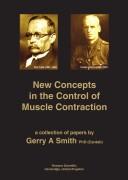
NEW CONCEPTS IN THE CONTROL OF MUSCLE CONTRACTION: A COLLECTION OF RESEARCH PAPERS
By GERRY A. SMITH
Subjects: Heart, Contraction, Muscle contraction
Description: This is a collection of papers that presents a novel interpretation of data from the literature to reason logically for an overlooked mechanism of stimulus-contraction coupling in muscle. This mechanism is then used to explain aspects of the puzzles relating to both an important physiological function of the heart, The Frank–Starling Law, and the basis of a common inherited disease state, familial hypertrophic cardiomyopathy (FHCM). The first three papers were published in the Biochemical Journal and are reproduced here by permission of the Biochemical Society Editors (Portland Press). The remaining five papers are an examination and reinterpretation of data in papers that are already published. Great care has been taken to attribute correctly these data to the publications and their authors. These latter papers have failed to get past the submission offices of a number of serious journals and thus will now have peer review in the public domain. Many published studies in this field have been excluded from subsequent consideration because they do not fit within the established “solely troponin-Ca<sup>2+</sup>-binding activated, single-headed myosin, multiple cross-bridge highly cooperative model of muscle contraction”. The purpose of the current study is to remove the words “solely” “single-headed” “multiple … highly cooperative” from this sentence to reveal the more simple; “a cross-bridge model of muscle contraction activated both by calcium binding to troponin and by calcium binding to myosin”. This encompasses the established principles of muscle stimulus-contraction coupling but adds the thick-filament activation that has been mooted often in the literature but never attributed a mechanistic basis. The Frank–Starling Law and Familial Hypertrophic Cardiomyopathy; Some new striking aspects of muscle structures <b>Contents</b><br> Author - ii<br> Preface - iii<br> Introduction - iv<br> <b>Paper I</b><br>Estimation of Systolic and Diastolic Free Intracellular Ca<sup>2+</sup> by Titration of Ca<sup>2+</sup> Buffering in the Ferret Heart - <b>I – 1</b><br> <b>Paper II </b><br>Ca<sup>2+</sup> buffering in the heart: Ca<sup>2+</sup> binding to and activation of cardiac myofibrils - <b>II – 1</b><br> <b>Paper III</b><br>The effect of Mg<sup>2+</sup> on cardiac muscle function; is CaATP the substrate for priming myofibril cross-bridge formation and Ca<sup>2+</sup> re-uptake by the sarcoplasmic reticulum? - <b>III-1</b><br> <b>Paper IV</b><br>The Frank–Starling Law of the Heart; Cross-bridge recruitment and Ca<sup>2+</sup> cooperativity - <b>IV – 1</b><br> <b>Paper V</b><br>Dual Ca<sup>2+</sup> Site Activation of Cardiac Muscle Contraction; Experimental isolation of the Ca<sup>2+</sup> controls - <b>V – 1</b><br> <b>Paper VI</b><br>The Frank–Starling Law of the Heart; The coupling of stretch to substrate change: A Review - <b>VI – 1</b><br> <b>Paper VII</b><br>The Frank–Starling Law and Familial Hypertrophic Cardiomyopathy; Some new striking aspects of muscle structures - <b>VII – 1</b><br> <b>Paper VIII</b><br>Biochemical Kinetic Calculations of Dual Ca<sup>2+</sup> Site Activation of Cardiac Muscle Contraction; The mechanisms of effectors - <b>VIII – 1</b>
Comments
You must log in to leave comments.